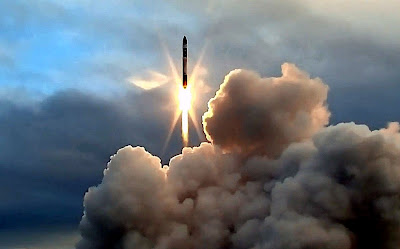Según lo publicado por la organización privada de inteligencia DEFCON Warning System, aunque actualmente no existen amenazas nucleares inminentes contra Estados Unidos, hay acontecimientos que invitan a admitir seriamente la posibilidad de que el Pentágono haya decidido mantener el nivel de alerta en DEFCON 4.
Voy a exponerlas a continuación, si bien quisiera recordar a los lectores que la DEFCON Warning System no está afiliada a ninguna agencia gubernamental. Por tanto, el lector debe hacer sus propias evaluaciones y no confiar ciegamente en DEFCON Warning System para llevar a cabo cualquier planificación estratégica.
Corea del Norte contra Estados Unidos
Las tensiones entre Corea del Norte y los Estados Unidos están aumentando: El intercambio de amenazas es cada vez más frecuente, aunque no parece haber señal alguna de un ataque inminente por parte de cualquiera de los dos países.
No obstante lo anterior, hay que señalar que el nivel de amenaza sigue siendo elevado y cada parte está actualmente a la defensiva, esperando algún tipo de acción por parte del bando opuesto: Estados Unidos ha amenazado con fuego y furia a Corea del Norte en caso de que su líder continúe con su plan de reducir Estados Unidos a cenizas mediante un ataque nuclear, o de que lleve a cabo su amenaza de dar Jaque Mate a Estados Unidos mediante un EMP.
Si el pasado mes de Julio existían dudas de la posibilidad de que Corea del Norte hubiera logrado miniaturizar una ojiva nuclear que pudiese caber dentro de sus misiles, a día de hoy se admite ya que el régimen de Kim Jong-un ha detonado una bomba de hidrógeno que Pyongyang asegura poder montar en sus misiles intercontinentales, en teoría capaces de llegar a Estados Unidos.
Aunque se ha mostrado ya un video calificado como propagandístico en el que se muestra una aparente Bomba H cargada en un aparente misil, para los expertos existen dudas sobre si tal artefacto es real, y si tal aparente misil puede realmente volar. En cualquier caso, Corea del Sur no duda que Corea del Norte pueda montar una ojiva nuclear en un misil y el Gobierno de Estados Unidos baraja la posibilidad de que Corea del Norte posea hasta sesenta bombas nucleares.
Todo lo anterior coloca a los Estados Unidos en peligro de sufrir un ataque directo por parte de Corea del Norte. A este respecto, China ha advertido a Corea del Norte que permanecerá neutral si ésta inicia una guerra contra los Estados Unidos, quien por su parte baraja la conveniencia de iniciar un ataque preventivo sobre Corea del Norte al objeto de neutralizar su capacidad militar.
Corea del Norte contra Corea del Sur
Corea del Sur está preparándose a la posibilidad de entrar en guerra caliente contra su vecino del norte, y su ejército ha participado a finales de agosto en unos juegos de guerra a gran escala junto con Estados Unidos, lo que indudablemente ha contribuido a elevar aún más la tensión entre ambas coreas. No obstante, desde el nombramiento del nuevo presidente el país empieza a mostrar una postura más débil que con el presidente anterior, y es probable que ello envalentone aun más a Corea del Norte, animándola a proseguir su programa nuclear.
Corea del Norte contra Japón
Recientemente, Corea del Norte lanzó un misil contra Japón, que sobrevoló su espacio aereo antes de caer en el mar. Ese lanzamiento ha reavivado las tensiones en la zona después de un período de calma relativa durante las semanas anteriores, impulsando a Japón a reconsiderar sus capacidades defensivas frente a un posible ataque de Corea del Norte, desplegando un nuevo sistema terrestre de defensa antimisiles.
China contra Estados Unidos
China viene advirtiendo a Estados Unidos que ayudará a Corea del Norte si Estados Unidos lanza un ataque preventivo contra Corea del Norte, y en fechas recientes ha probado otro nuevo misil anti-satélite que constituye una amenaza potencial para Estados Unidos, habida cuenta de su fuerte dependencia de la tecnología satelital.
Irán contra Israel
Irán ha presentado un nuevo misil balístico dotado de MIRVs capaces de alcanzar a Israel.
Estados Unidos con Japón y Corea del Sur
Estados Unidos contempla mejorar la defensa antimisiles de Japón, y el USS Ronald Reagan está llevando a cabo maniobras con fuerzas japonesas y surcoreanas cerca de la Península de Corea.
Rusia con India
Rusia y la India tendrán sus primeros juegos de guerra conjunta en octubre, lo cual servirá para estrechar aún más los existentes lazos militares entre ambas potencias nucleares.
Naciones Unidas con Iran
Las Naciones Unidas se han negado a inspeccionar las instalaciones militares iraníes para cumplir con el acuerdo nuclear, afirmando que tales inspecciones son innecesarias, y es probable que ello envalentone aun más a la república islámica, animándola a acelerar su programa nuclear.























